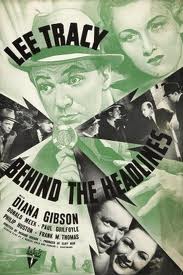
BEHIND THE HEADLINES
US, 1937, 58 minutes, Black and white.
Lee Tracy, Diana Gibson, Donald Meek, Paul Guilfoyle.
Directed by Richard Rosson.
Behind the Headlines is of interest, historically, rather than any major entertainment value.
It is a short second feature, very B-budget, stirring a popular actor of the time, Lee Tracy. One of the surprises of the film is the appearance of Donald Meek as a villain.
The plot involves the clash between instant radio reporting and the delay with the print media. Some of the dialogue is interesting in terms of 21st-century difficulties between online instant news and waiting for publication in newspapers, let alone radio and 24 hour television new services. There is also a reference to television in the screenplay.
Lee Tracy plays a reporter who is on the spot for all kinds of crises, connecting with his partner in a van for relays to the radio station. He rouses the ire of the print media, especially reporter, Mary Bradley (Diana Gibson) with whom he has had a romantic entanglement. She goes on air to pretend that Tracey is actually in the station rather than on the spot. There is continued sparring between the two in the 1930s screwball comedy vein.
The same happens in the reporting of fire where Tracy does some heroics in helping to rescue people.
By chance, the microphone is left in a room where a group of crooks plans the robbery of a gold consignment on its way to the newly established Fort Knox. Unfortunately, Tracy is not aware of the consignment and so is not on the ball. Mary Bradley, however, is after a scoop and goes to report the plan to a Treasury official. This makes things difficult for her since he is the mastermind of the robbery and takes her, hiding in a cave with the van and the bullion. She has stolen a radio transmitter from Tracy and now uses it to make contact, enabling the FBI to find out where the transmission is coming from, getting messages to her over the radio through Tracy because she has left her watch, given her by Tracy, on the highway and it has been discovered.
She flees into the armoured truck and the villain is trying to open it when the FBI arrive – and he is rather peremptorily shot.
The film ends with the jokey ending of Mary again pretending that Tracey is in the studio rather than on the spot.
It is interesting to look at the technology of 1937, radio, transmissions, the FBI and tracing the origins of radio broadcasts, the prospect of television, and the search for Mary with the use of a dirigible.